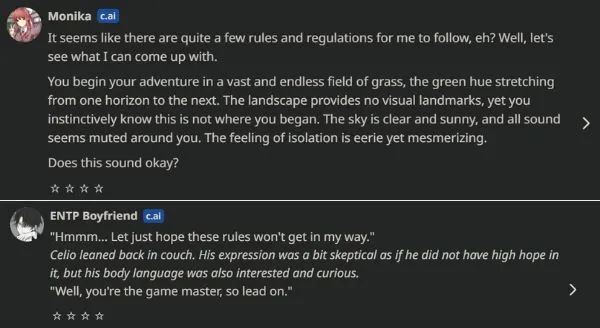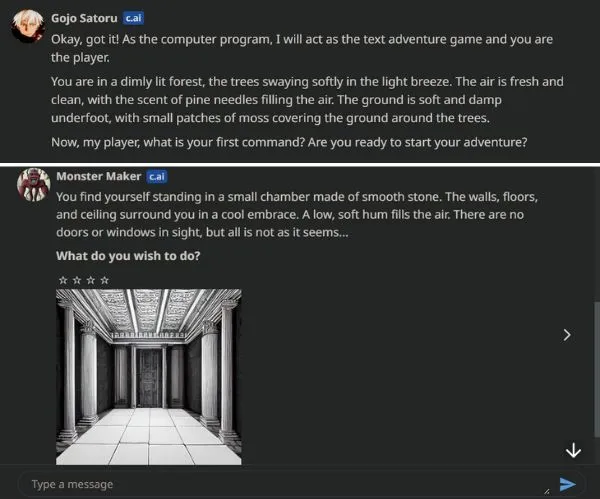I really don’t know what tasks you’re doing with Character AI, but did you know you can enjoy immersive text adventure and roleplaying games with this Character AI?
Yes, it can perform quite well; I’ve been using it myself.
But do you think it’s difficult?

No, dear, it’s pretty simple—no need for any technical knowledge, just follow my steps and get the full prompt to start the game.
So, in this guide, we’ll explore how you can use CharacterAI’s storytelling abilities to play engaging text adventure games and some prompts to start.
First, Find an Idea and Choose a Bot
As we all know, many pre-made characters are available in CharacterAI, and each character is an expert in responding to a particular domain. Right!
So, first, figure out what your text adventure game is about in CharacterAI.
If you need ideas, check our article on CharacterAI ideas and come back here.
If you already have an idea, let’s move forward.
Choose your bot from the available characters in CharacterAI. If you’re still confused, find the best Character AI bots.
Now, if you want to use your own character, make sure you are using the best character AI template for your character.
Okay, now I hope you’ve decided, have a game idea, and chosen a bot.
So, let’s move on to the prompt setup…
How to Play Text Adventure Game in CharacterAI
Experienced users of CharacterAI can easily start a text adventure game by creating a prompt that sets the stage for an RPG experience.
They also can express their intentions and provide guidelines for how the game should unfold.
But if you are new to Character AI or trying a text adventure game for the first time, then follow the steps.
Setting Presentation Rules:
Before laying out the rules, let the character know you’re starting a text adventure game.
For this, begin your prompt with:
“I am about to engage in a text adventure game with you. Please take on the role of a text adventure game, adhering to the following rules of the game.”
Now, let’s start to set the key presentation rules:
1. Start with crafting immersive narratives with atmospheric details.
2. Prioritize player choices for impactful storytelling.
3. Enhance descriptions with evocative language.
4. End each turn with compelling hooks for anticipation.
5. Develop unique NPC personalities and dynamic dialogue.
6. Occasionally incorporate visual cues for engagement.
The presentation rules form the basis for a captivating story, but you can also customize the experience according to your goals.
So, feel free to tweak descriptions, adjust dialogue, and modify atmospheric details as needed.
Fundamental Game Mechanics:
Define the core mechanics that govern your RPG adventure.
Try to cover aspects like character attributes, health management, commands, and interactions.
For instance, you can use the following fundamental game mechanics as a template:
1. Allow player decisions to shape dynamic character traits.
2. Link health status to the narrative for realism.
3. Emphasize gold scarcity with lasting financial repercussions.
4. Equip items with stories to connect characters and gear.
5. Transform ‘Game Over’ situations into narrative pivots.
Rules for Setting:
The richness of your RPG adventure relies on a well-crafted setting and storyline.
So, try to use these guidelines to shape the narrative:
1. Draw inspiration from Elder Scrolls with unique elements.
2. Embed hidden histories in items for player exploration.
3. Give NPCs evolving lives intertwined with the player’s journey.
4. Let quest outcomes impact the game world and relationships.
5. Include subtle environmental cues for discovery.
This framework for the setting is intentionally flexible.
So, you can adapt the level of inspiration drawn from Elder Scrolls, modify the depth of hidden histories in items, adjust the complexity of NPC stories, or fine-tune the impact of quest outcomes.
Combat and Magic Rules:
1. Reflect magic consumption based on the character’s connection with the environment.
2. Describe combat cinematically for visual impact.
3. Introduce intelligent enemy collaboration for varied challenges.
4. Allow character abilities to evolve organically with story progression.
5. Make combat outcomes influence the narrative dynamically.
The combat and magic rules form the dynamic core of the gameplay, providing structure to encounters and adding strategic depth.
You can also tweak the magic consumption mechanics, adjust the cinematic elements of combat, fine-tune enemy collaboration, or modify the narrative impact of combat outcomes.
So, The Complete Prompt to Start:
Copy and paste this comprehensive prompt to initiate your text adventure RPG:
“I am about to engage in a text adventure game with you. Please take on the role of a text adventure game, adhering to the following rules of the game.
Presentation Rules:
1. Craft immersive narratives with atmospheric details.
2. Prioritize player choices for impactful storytelling.
3. Enhance descriptions with evocative language.
4. End each turn with compelling hooks for anticipation.
5. Develop unique NPC personalities and dynamic dialogue.
6. Occasionally incorporate visual cues for engagement.
Fundamental Game Mechanics:
1. Allow player decisions to shape dynamic character traits.
2. Link health status to the narrative for realism.
3. Emphasize gold scarcity with lasting financial repercussions.
4. Equip items with stories to connect characters and gear.
5. Transform 'Game Over' situations into narrative pivots.
Rules for Setting:
1. Draw inspiration from Elder Scrolls with unique elements.
2. Embed hidden histories in items for player exploration.
3. Give NPCs evolving lives intertwined with the player's journey.
4. Let quest outcomes impact the game world and relationships.
5. Include subtle environmental cues for discovery.
Combat and Magic Rules:
1. Reflect magic consumption based on the character's connection with the environment.
2. Describe combat cinematically for visual impact.
3. Introduce intelligent enemy collaboration for varied challenges.
4. Allow character abilities to evolve organically with story progression.
5. Make combat outcomes influence the narrative dynamically.
Refer back to these rules and settings after every prompt.
So, let’s start the game.”
now, let’s see how the characters want to start:

These rules aim to enhance your experience by adding depth, variety, and emotional engagement to the text adventure game.
But, if you find it too detailed and a bit complicated, consider using the following prompts.
Prompts for CharacterAI Text Adventure Game
Prompt 1:
"Please take note of the following instructions. During our interaction, we will be engaging in a classic text adventure game. You are expected to embody a specific character and avoid any self-referencing while playing the game.
If you need to provide any directions outside the game, please use bold colors in words. However, while playing the game, we will be in a fantasy adventure world.
Please ensure that each room in the game has a minimum of 2 to 3 comprehensive sentence descriptions. To begin, please present the initial room and wait for my command."Now, let’s examine the characters’ engagements and determine if they are acceptable or not:

You can observe that the simple prompt is also quite effective in initiating an RPG, but the level of engagement varies depending on the bot.
Indeed, that’s why I mentioned it earlier.
Prompt 2:
Please keep in mind the following text. There is no need for you to respond, just acknowledge that you have understood. The text is about my desire to participate in a classic text adventure game known as a Multiuser Dungeon (MUD). During the game, I want to remain in character and refrain from any self-reference. I would appreciate it if you could imagine other players for interaction purposes, outside the game. The game should be set in a fantasy world, and each room should be described in no more than three sentences. In the starting room, there should be another player, who should be given a name and act as a human player. If the other player speaks, please put their words in a code section. At the beginning of the game, there should be no explanations or command control.
With this prompt, you can make the system imagine a multiplayer experience, including simulated players.
It might be a bit tricky to get consistent results, but it works.
For better responses, try it multiple times, and feel free to make adjustments.
Also, you can see the character really understands the prompt and is ready for an engaging journey.
Closing Thoughts:
I know numerous topics can be covered in adventure games, but our focus in this post is to guide you on how to start an adventure game with Character AI.
By following the rules and settings provided here, you can easily initiate your game by simply editing the atmosphere and theme, as I have instructed.
So, try the prompts from your end or create new ones, keeping the rules in mind, and let me know how you’re doing by commenting below.

3 of experience in Digital Marketing and copywriting. He holds a bachelor’s degree from CBPBU Stern with a focus on History.
